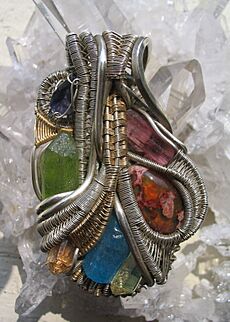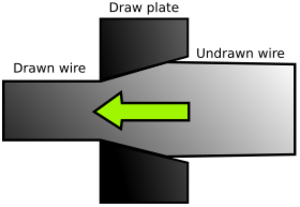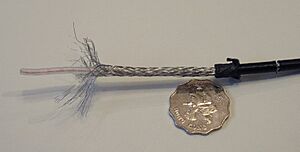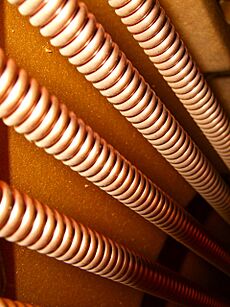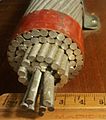Wire facts for kids
A wire is a long, thin piece of metal that is usually round. Think of it like a flexible metal string!
Wires are often made by pulling metal through a special hole in a tool called a die or draw plate. This process is called drawing. Wires come in different standard sizes, which are measured by a "gauge number" or by their "cross-sectional area" (how big they are when you look at the end).
Wires are used for many things. They can hold heavy things, like in wire rope. In electricity and for sending signals, a "wire" can be part of an electrical cable. This cable might have one solid wire inside, or many smaller wires twisted together.
While most wires are round, they can also be made in other shapes like square, hexagonal, or flat. These different shapes can be for decoration or for special uses, like in loudspeakers.
Contents
How Wires Were Made Long Ago
People have been making and using wire for thousands of years! In ancient times, wire was often used to make beautiful jewelry, like chains and decorations.
One early way to make wire was by cutting thin strips from metal sheets. Then, these strips were pulled through small holes in stone beads. This made the strips fold up into thin tubes, which looked like wire. This method was used in Egypt around 2890 to 2686 BCE.
Later, around 1500 BCE, people started making gold wires that had a spiral seam. These were made by twisting metal strips. They could then be rolled flat to make solid round wires. The method of pulling metal through a die (called "drawing") became more common in the ancient world between about 700 and 900 CE.
Sometimes, square or hexagonal wires were made by hitting a metal rod between grooved metal blocks. This method, called "swaging," was also very old, possibly used in Egypt around 2000 BCE.
A special type of decorative wire, called "beaded wire," looked like a line of tiny beads. It appeared around 700 BCE in places like the Eastern Mediterranean. Later, people found it easier to just twist two round wires together to make a "rope" design.
In England, wire drawing started in the Middle Ages. The wire was used to make things like wool cards and pins. Even when wire mills were built, making very thin wires was still often done by hand.
In the early 1900s, people used special tools called "draw-plates" or "dies" to make wire. These dies were made of hard metal, or sometimes even diamonds or rubys for very fine wires. Precious stones were used because they wouldn't wear out as quickly, ensuring the wire stayed the correct size.
How Wires Are Made Today

Today, wire is usually made by repeatedly pulling it through smaller and smaller dies. This makes the wire thinner and gives it the right properties. After being pulled many times, the wire might be heated in a process called annealing. This makes the wire softer and better at conducting electricity.
Many electrical wires are covered with insulating materials like plastic or rubber. This insulation keeps the electricity safely inside the wire. Wires are covered by passing them through a machine called an extruder. In the past, cloth, paper, or oil-based products were used for insulation.
Sometimes, two or more wires are wrapped together with insulation in between to create a coaxial cable. Wires and cables can also be protected with other materials like paraffin, bitumen, or metal coverings. Special machines wind these materials onto the wire as it moves quickly.
For larger cables, like those used for electric light and power, or even underwater cables, the machines are bigger. They carefully wind many strands of covering material onto the cable, making sure everything is wrapped tightly and evenly.
Different Kinds of Wires
Solid Wires
Solid wire, also called solid-core wire, is made of a single piece of metal. It's often cheaper to make than other types of wire. Solid wire is good for wiring things that won't move much, like inside breadboards or walls. It's also very strong and can resist damage from the environment because it has less surface area exposed.
Stranded Wires

Stranded wire is made of many small wires twisted or bundled together. Because it's made of many smaller pieces, stranded wire is much more flexible than a solid wire of the same size. This flexibility is important when the wire needs to move a lot without breaking.
You'll find stranded wire in things like A.C. cords for appliances, musical instrument cables, and computer mouse cables. It's also used in control cables for moving machine parts.
When electricity flows at very high frequencies, it tends to travel near the surface of the wire. This is called the "skin effect." While ordinary stranded wire doesn't really stop this, special types like litz wire (where each strand is insulated) can help.
Stranded wire might have slightly higher resistance than a solid wire of the same diameter because there are tiny gaps between the strands. However, for many uses, the flexibility is more important.
The more individual strands a wire has, the more flexible and resistant to breaking it becomes. For example, a wire with 7 strands is common, but 19 strands is better for wires that might move. For things that move constantly, like robot arms or headphone wires, 70 to 100 strands are often used. Very large cables can have thousands of tiny strands!
Sometimes, stranded wire is "prefused," meaning the strands are coated with tin and then fused together. This type of wire acts a bit like solid wire but is less likely to break.
Braided Wires
A braided wire is made of many small strands woven together, like a braid. Braided wires are very flexible and don't break easily when bent. They are often used as a shield in cables to reduce electromagnetic interference (noise).
What Wires Are Used For
Wires are used in countless ways! They are the basic material for many products. For example, they are used to make wire netting, springs, and wire rope. Wire-cloth, which is like a fabric made of wire, is used for sifting, window screens, and more.
Huge amounts of aluminum, copper, nickel, and steel wire are used for phone and data cables. They also carry electricity in electric power transmission and are used for electrical heating. Wires are also important for fencing, building suspension bridges, and making cages.
In musical instruments like violins, cellos, and guitars, wires are used as strings. For lower-pitched sounds, the main wire might be wrapped with another, finer wire. This makes the string heavier and lowers its pitch.
Not all metals can be made into useful wire. The metal needs to be ductile (meaning it can be stretched without breaking) and strong. The best metals for wire include platinum, silver, iron, copper, aluminum, and gold. Alloys (mixtures of metals) like brass and bronze are also used.
Very thin wires can be made with careful work. Special wires are also made from other metals, like tungsten wire for light bulbs, because it can handle very high temperatures. Copper wires are sometimes coated with tin, nickel, or silver for different uses, like handling heat or making it easier to remove insulation.
Here are some specific examples of wires:
- Hook-up wire is a small to medium-sized wire, either solid or stranded, with insulation. It's used for making connections inside electronic devices.
- Wire bonding uses tiny, microscopic wires to connect parts inside computer chips.
- Magnet wire is usually solid copper wire covered only with varnish, not thick plastic. This allows it to be wound very tightly to make electromagnetic coils for motors, transformers, and generators.
- Coaxial cable has an inner wire surrounded by insulation, then another layer of conductor (often braided wire), and finally an outer insulating layer. It's used for sending radio signals and protects signals from outside interference.
- Speaker wire connects loudspeakers to audio amplifiers. Some high-quality speaker wire has many individually insulated conductors.
- Resistance wire has a higher than normal electrical resistance. It's often used in heating elements, like in toasters, or to make resistors. Nichrome wire is a common type.
Other types of wire include:
- High-voltage cable
- Barbed wire
- Chicken wire
- Razor wire
- Tinsel wire
- Wollaston wire
See also
 In Spanish: Alambre para niños
In Spanish: Alambre para niños
Images for kids


